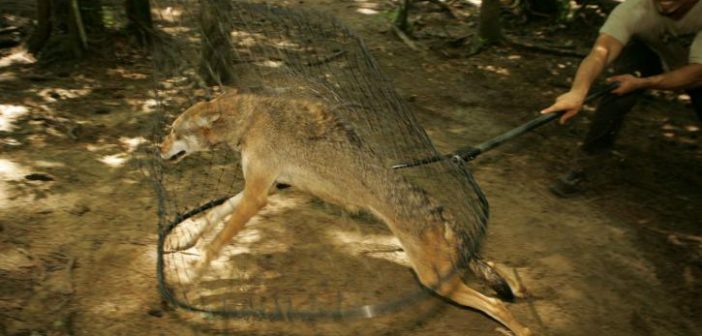(Featured image: red wolf being captured in net. Credit Steve Hillebrand / U.S. Fish and Wildlife Service, public domain)
CHAPEL HILL, N.C. – Conservation groups late Monday, June 20th asked the U.S. District Court for the Eastern District of North Carolina to stop the U.S. Fish and Wildlife Service (FWS) from capturing and killing—and authorizing private landowners to capture and kill—members of the rapidly dwindling population of wild red wolves. The conservation groups—represented in court by the Southern Environmental Law Center—are the Red Wolf Coalition, Defenders of Wildlife, and the Animal Welfare Institute.
Previously, the agency stopped key conservation actions and began authorizing private landowners to kill red wolves on their land. It also has been capturing wolves throughout the five-county red wolf recovery area in North Carolina, and holding them for weeks or months before releasing them into unfamiliar territory, separated from their mates and pack. This practice has raised concerns for conservation groups and scientists who are worried it is harming individual wolves and the population as a whole.
“The U.S. Fish and Wildlife Service is charged with conserving and recovering this country’s endangered species, but for red wolves it seems to have them on a path towards extinction,” said Sierra Weaver, senior attorney for the Southern Environmental Law Center who represents the conservation groups before the court. “The Service says it’s looking at whether to move forward with the population, but we’re worried there’s not going to be any population left if these actions continue. We’re asking the court to step in and save the wild red wolf.”
The groups brought the federal agency to court for its failure to protect the world’s only wild population of red wolves—previously estimated to be over 100 animals. Court filings detail a population decline of 50% over the course of two years, as well as the agency’s ongoing actions and inactions that continuing to imperil the survival and recovery of the species. As one example of FWS’s failure to protect red wolves, the groups cite its 2015 authorization of a private landowner to kill a breeding female that was exhibiting denning behavior, after minimal efforts by the agency to save the animal. There are now only 45 known wild red wolves still living.
“This species is running out of time. We have a short window to put red wolves back on a path to recovery or we will lose the last wild population in America,” said Jason Rylander, senior attorney for Defenders of Wildlife, said. “The U.S. Fish and Wildlife Service needs to get its red wolf program back on track and start taking actions that will help, not hinder, recovery.”
Under the Endangered Species Act, it is unlawful for anyone to “take” (i.e., harass, harm or kill) a red wolf, except in limited circumstances. Federal regulations authorize FWS to issue permits to take red wolves on private property after a property owner requests that wolves be removed from their property and the agency abandons efforts to capture them. For twenty years FWS only allowed the taking of “problem wolves,” those that threatened human safety or property, yet it recently expanded its activities to capture – and in some cases allow private landowners to kill – any wolves that enter private land.
“Before it’s too late for these remaining wolves, the U.S. Fish and Wildlife Service must rededicate itself to ensuring the survival of America’s rarest wolf and restore the former successful recovery of this endangered species,” said Red Wolf Coalition executive director Kim Wheeler.
The FWS announced in June 2015 that it would suspend the reintroduction of red wolves into eastern North Carolina. The agency also stopped its adaptive management for the population which has been critical to reducing hybridization with coyotes.
“It makes absolutely no sense for the Service to take a successful reintroduction program like this and actively drive it into the ground,” said Tara Zuardo, a wildlife attorney with the Animal Welfare Institute. “Americans wholeheartedly support red wolves; it’s the Service’s job to foster recovery of endangered species; now it’s time for the agency to do its job.”
Red wolves bred in captivity were reintroduced on a North Carolina peninsula within their native range in the late 1980s after the species was declared extinct in the wild. Once common throughout the Southeast, intensive predator control programs and loss of habitat decimated wild red wolf populations.





